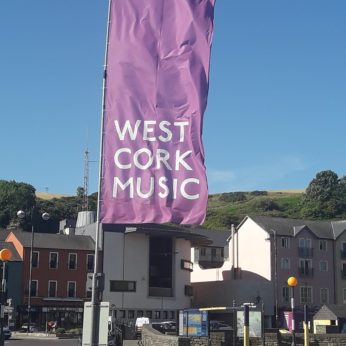Composer: Elizabeth Maconchy (b. 1907 - d. 1994)
Performance date: 01/07/2018
Venue: St. Brendan’s Church
Composition Year: 1936
Duration: 00:21:44
Recording Engineer: Ciaran Cullen, RTÉ
Instrumentation: 2vn, va, vc
Instrumentation Category:String Quartet
Artists:
Quatuor Danel (Marc Danel, Gilles Millet [violins], Vlad Bogdanas [viola], Guy Danel [cello]) -
[quartet]

17. CRESPO SERIES – ST BRENDAN’S CHURCH 16.00
Quatuor Danel
Marc Danel, Gilles Millet [violins]
Vlad Bogdanas [viola]
Yovan Markovitch [cello]
Elizabeth Maconchy [1907-1994]
String Quartet No.2 [1936]
1. Molto lento
2. Poco presto
3. Lento sostenuto
4. Allegro
Elizabeth Maconchy always thought of herself as an English composer as she lived in England all her adult life. However she had strong Irish connections – both her parents were Irish, she spent most of her childhood in rural Ireland and her husband, the scholar and medical historian William LeFanu, was Irish of Huguenot descent. Although she studied with Vaughan Williams, her music eschews the English pastoral for a more gutsy connection with the European mainstream of Bartók and Janá?ek.
Maconchy wrote extensively on the art of composition and the string quartet in particular. Why a String Quartet? What is it that has given it its exalted reputation and mystique? Why have so many composers regarded it as the perfect medium of expression, though it is perhaps the most demanding to write for? And why do distinguished artists often prefer to work as a team in a first class quartet than make bigger money as a soloist? Music means different things to different people: but for those to whom music is an intellectual art, a balanced and reasoned statement of ideas, an impassioned argument, an intense but disciplined expression of emotion – the string quartet is perhaps the most satisfying medium of all.
And lest we think intellect outweighs emotion in her music – I have tried to express my ideas mainly by means of counterpoint: that is, the combination of several independent melodic lines, moving horizontally, to make sense vertically. And I use a counterpoint of rhythms as well as of melodic lines – so you may have two or more independent rhythms working together simultaneously. And the object of all this is to achieve a more concentrated expression of the emotion implicit in the musical ideas themselves, because, despite the intellectual cast of my work, the expression of emotion has always been for me the underlying stimulus for writing music.
Maconchy was born the year after Shostakovich and, perhaps more significantly, twenty years after Rebecca Clarke, who may have helped to pave the way for women composers in the male-dominated English music scene although the prejudice against female composers persisted until quite recently. Maconchy’s Second Quartet seems years ahead of its time, the opening viola melody unfolding over a cello drone could have been written by Gorecki over fifty years later. This grows inexorably to several powerful statements of the theme before building to the fff climax of the movement. The Scherzo begins deceptively quietly but its jagged and capricious rhythms soon take over, creating an anarchic movement with many faces. It moves without a break into a slow movement of long extended lines constantly interrupted by startling, agitated fragments. Gradually the fragments come together to create a single, brief moment of calm beauty before it all falls apart again and seeks fulfilment in a series of resonating climaxes. These eventually subside into the pizzicato opening of the lively, rhythmically complex last movement. This proves to be a cross-play of rhythmic and melodic counterpoints before all is drawn together and resolved in the coda.
Francis Humphrys
Copyright © 2025 West Cork Music. All rights reserved.
Designed and developed by Matrix Internet